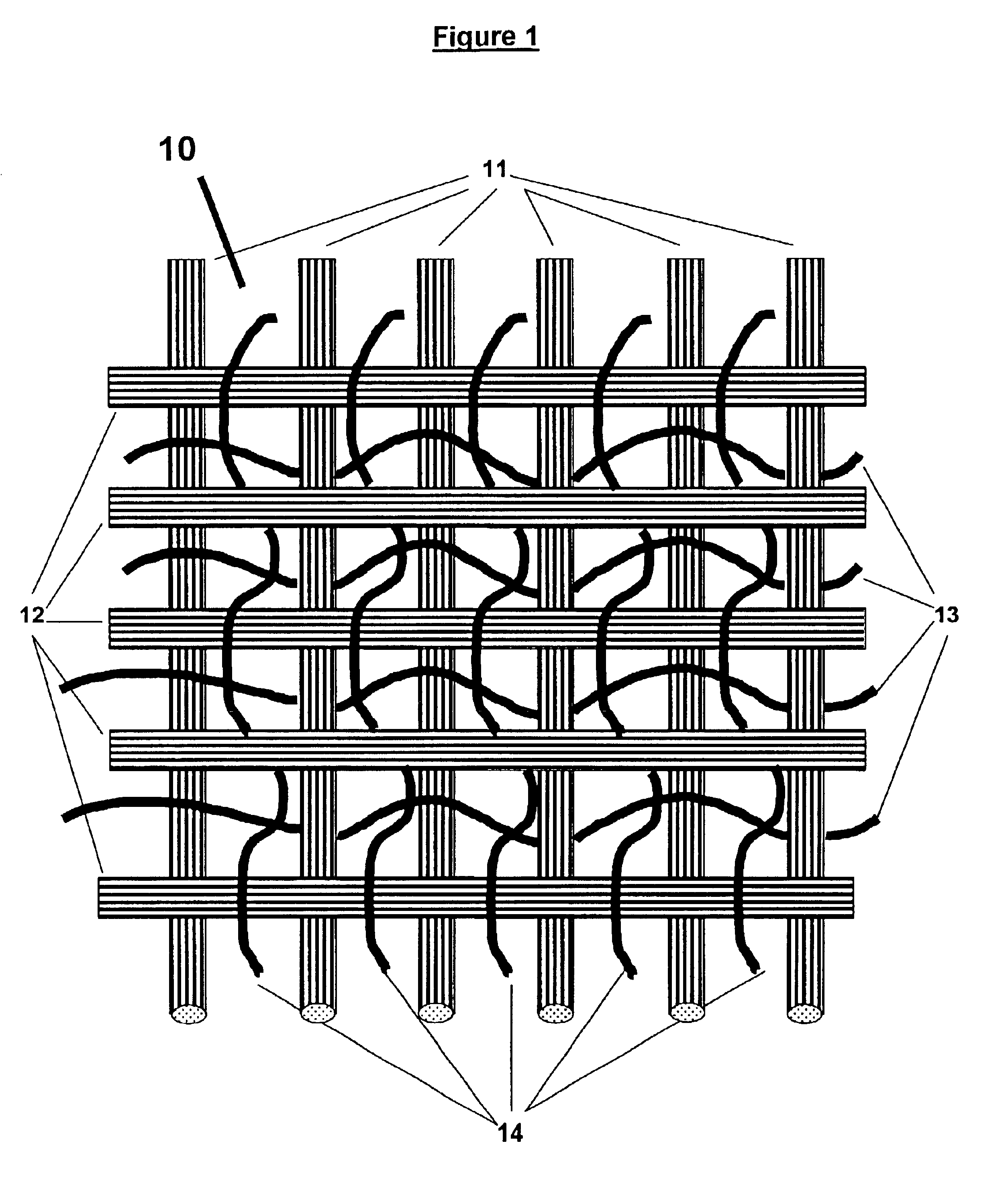Bi-directional and multi-axial fabrics and fabric composites
a multi-axial fabric and fabric technology, applied in the direction of protective fabrics, straight-bar knitting machines, synthetic resin layered products, etc., can solve the problems of poorer ballistic resistance of woven or knitted fabrics than cross-plied, and achieve superior ballistic effectiveness, superior penetration resistance, and easy manufacturing
- Summary
- Abstract
- Description
- Claims
- Application Information
AI Technical Summary
Benefits of technology
Problems solved by technology
Method used
Image
Examples
second embodiment
In a second embodiment, an article of the invention comprises a bi-directional knitted fabric comprised of a first set of continuous filament unidirectional yarns lying in a first plane; a second set of continuous filament unidirectional yarns lying in a second plane above said first plane and arranged transversely to said first set of yarns; a third set of interlacing yarns forming interlocking loops interlaced with said first and said second set of yarns, each yarn of the third set lying above some and below the remaining yarns of said first set and said second set of yarns; wherein each of the yarns comprising said first and second sets of yarns have tenacity's equal to or greater than about 15 g / d, initial tensile moduli equal to or greater than about 400 g / d and energies-to-break equal to or greater than about 22 J / g as measured by ASTM D2256; and wherein each of the yarns comprising said first and second sets of yarns, in proportion to the yarns comprising said third set of ya...
third embodiment
In a third embodiment, an article of the invention is a multi-axial knitted fabric comprised of: a set of continuous filament unidirectional yarns in a bottom plane; a plurality of intermediate planes above said bottom plane each defined by a set of continuous filament unidirectional yarns; a set of continuous filament unidirectional yarns in a top plane; a set of interlacing yarns forming interlocking loops, said loops binding the sets of unidirectional yarns in all planes; wherein the set of unidirectional yarns in each said plane is rotated at an angle relative to the set of unidirectional yarns in adjacent planes; wherein the yarns of each said set of unidirectional yarns have tenacity's equal to or greater than about 15 g / d, initial tensile moduli equal to or greater than about 400 g / d and energies-to-break equal to or greater than about 22 J / g, all as measured by ASTM D2256; and wherein the yarns of each said set of unidirectional yarns, in proportion to said interlacing yarns...
example 1
A bi-directional fabric of the invention was woven on an American Iwer Model A2 180 loom. The fabric consisted of four yarn sets. The first yarn and second yarn sets each consisted of parallel highly oriented, high molecular weight continuous filament polyethylene yarns (SPECTRA® 1000 from Honeywell International Inc.) of 1300 denier and having a tenacity of 35 g / d, initial tensile modulus of 1150 g / d, energy-to-break of 45 J / g, breaking strength of 45 Kg and 3.4% elongation at break. Referring to the schematic representation of FIG. 1, the first yarn set 11 and the second yarn set 12 were unidirectionally oriented transverse to one another in separate planes, one above the other. A third yarn set 13 arranged transversely to the first yarn set 11 and interlaced with the yarns of the first set consisted of polyvinyl alcohol yarns of 75 denier and having a breaking strength of 0.38 Kg and 20% elongation at break. A fourth yarn set 14 arranged transversely to the second and third yarn ...
PUM
| Property | Measurement | Unit |
|---|---|---|
| angle | aaaaa | aaaaa |
| angle | aaaaa | aaaaa |
| melting points | aaaaa | aaaaa |
Abstract
Description
Claims
Application Information
 Login to View More
Login to View More - R&D
- Intellectual Property
- Life Sciences
- Materials
- Tech Scout
- Unparalleled Data Quality
- Higher Quality Content
- 60% Fewer Hallucinations
Browse by: Latest US Patents, China's latest patents, Technical Efficacy Thesaurus, Application Domain, Technology Topic, Popular Technical Reports.
© 2025 PatSnap. All rights reserved.Legal|Privacy policy|Modern Slavery Act Transparency Statement|Sitemap|About US| Contact US: help@patsnap.com



